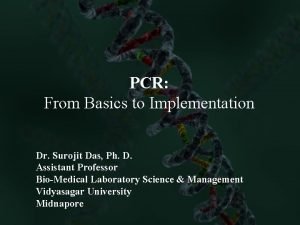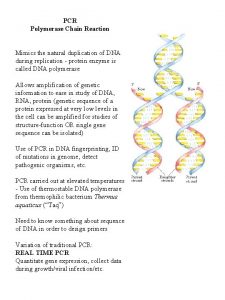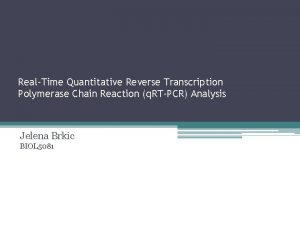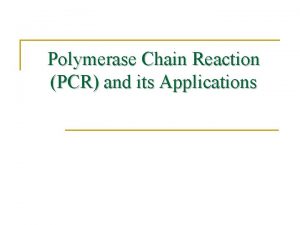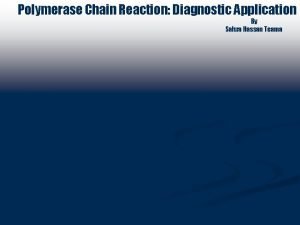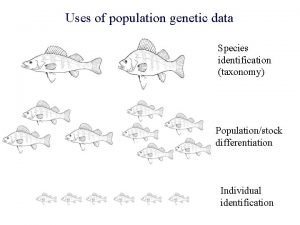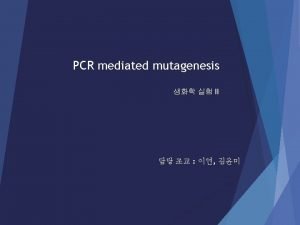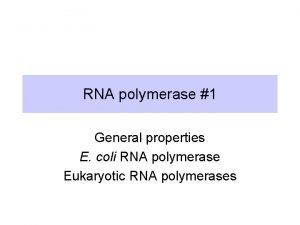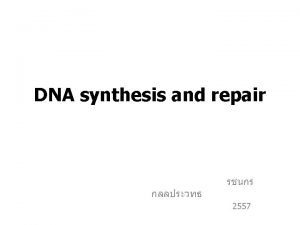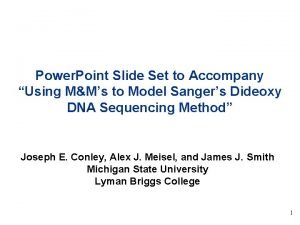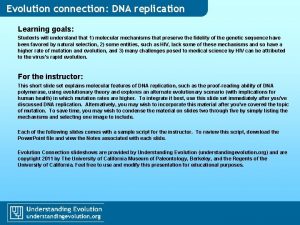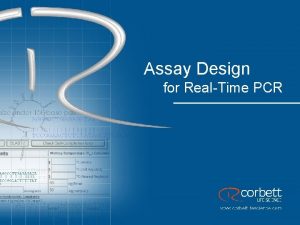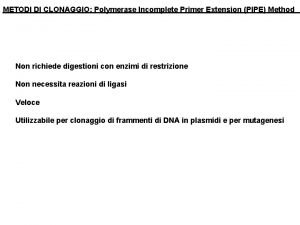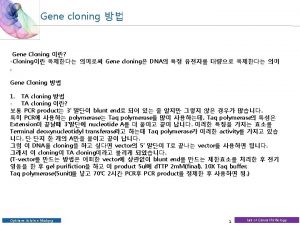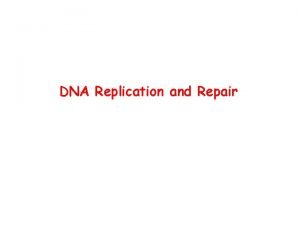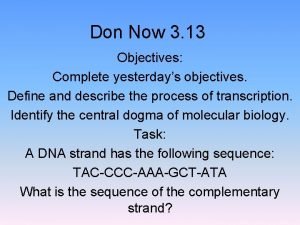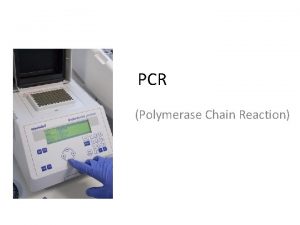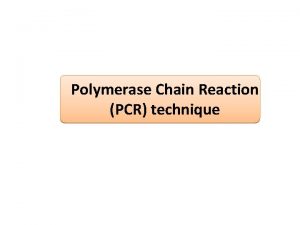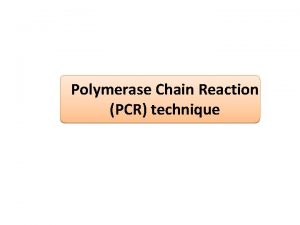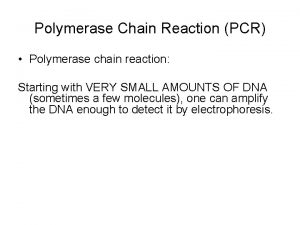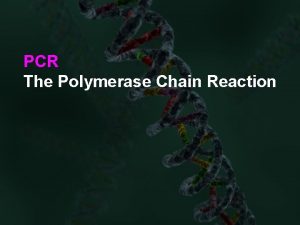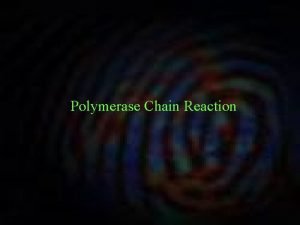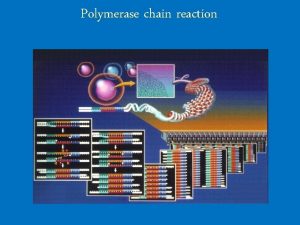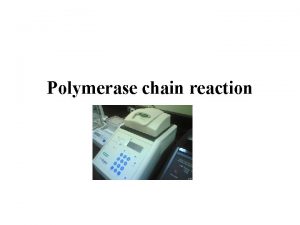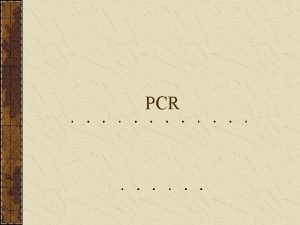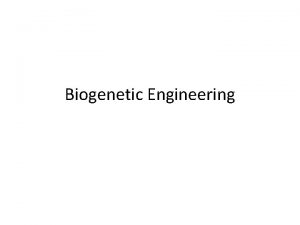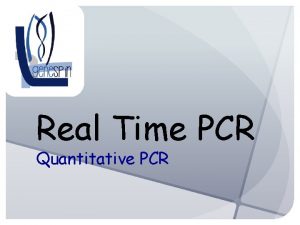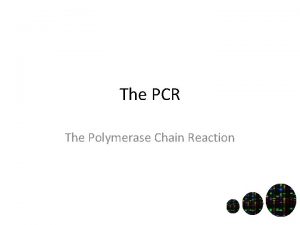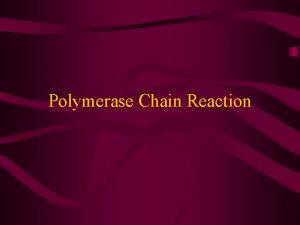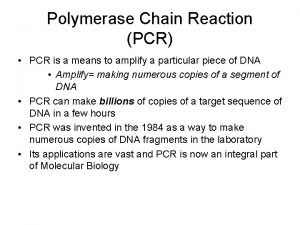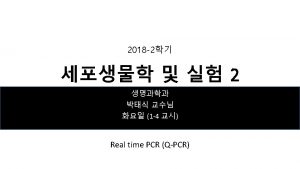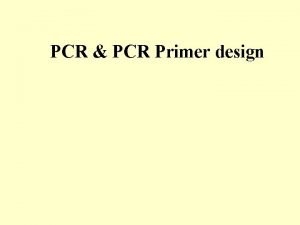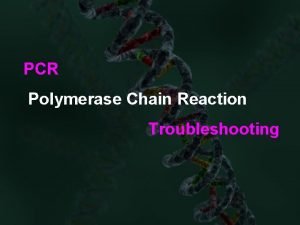Polymerase Chain Reaction PCR Whats the point of

























- Slides: 25

Polymerase Chain Reaction (PCR)

What’s the point of PCR? • PCR, or the polymerase chain reaction, makes copies of a specific piece of DNA • PCR allows you to look at one specific piece of DNA by making copies of *only* that piece of DNA • PCR is like looking for a needle in a haystack, and then making a haystack out of the needle

PCR in Medicine • Genetic testing - a sample of DNA is analyzed for the presence of genetic disease mutations • Tissue Typing – for organ transplantation • Look at cancer gene mutations (oncogenes) • Detection of disease organisms

PCR in Research • Gene Mapping (Human Genome Project) • DNA Sequencing • Site-Directed Mutagenesis … and many more

PCR in Forensics • Parental Testing • Genetic Fingerprinting (Used in Crime Scene Investigations)

How do crime scene investigators create a DNA profile? 1. Evidence is collected at the crime scene: Blood Teeth Tissue Semen Hair Saliva Urine Bone

How do crime scene investigators create a DNA profile? 2. DNA is extracted from sources at the crime scene and from victim and suspects

How do crime scene investigators create a DNA profile? 3. DNA samples are processed Sample Obtained from Crime Scene or Paternity Investigation DNA Extraction Biology DNA Quantitation PCR Amplification of multiple (STR) markers Technology Separation and Detection of PCR Products (STR Alleles) Sample Genotype Determination Genetics Comparison of Sample Genotype to Other Sample Results Generation of Case Report with Probability of Random Match If match occurs, comparison of DNA profile to population databases

Since humans are 99. 9% identical where do crime scene investigators look for differences in DNA profiles? 4. Crime Scene Investigators search in areas of the genome that are unique from individual to individual and are “anonymous” (control no known trait or function) The areas examined are Short Tandem Repeats or STR’s STR region

Example of an STR: TH 01 The TH 01 locus contains repeats of TCAT. CCC TCAT TCAT AAA This example has 6 TCAT repeats. There are more than 20 known TH 01 alleles. Each individual inherits 1 allele from each pare

Determining genotypes for individuals using STRs Ms. Smith’s TH 01 locus for her two chromosomes is given below. What is her genotype? MOM’S CHROMOSOME CCC TCAT TCAT AAA DAD’S CHROMOSOME CCC TCAT TCAT TCAT TCAT AAA

To determine the genotype (DNA profile) Crime Scene Investigators make billions of copies of the target sequence using PCR Target DNA 5’ 3’ 3’ 5’ Starting DNA Template

DNA profiling is used to determine which suspect can not be excluded from suspicion.

How are suspects included or excluded from an investigation? • Suspects are included in an investigation if their DNA profile matches with genotypes found at the crime scene • Suspects can be excluded if their DNA profile does not match genotypes found at the crime scene

Crime Scene Investigator PCR Basics™ Procedures Overview

Laboratory Quick Guide

Set up PCR reactions 1. Find the PCR tubes at your station. Label them ‘CS’ for Crime Scene DNA, ‘A’ for Suspect A DNA, ‘B’ for Suspect B DNA, ‘C’ for Suspect C DNA, and ‘D’ for Suspect D DNA. 2. Keeping the tubes on ice, add 20 μl of Master Mix + blue primers to each tube. 3. Keeping the tubes on ice, add 20 µl of each DNA to the appropriately labeled tube. 4. USE A FRESH TIP EACH TIME! 5. Mix and put in thermal cycler 6. Cycle ~3 hours

What is needed for PCR? The PCR Reaction What do you need? • Template (containing the STR you want to amplify for the study) • Sequence-specific primers flanking the target sequence 5’ 3’ Reverse primer 5’ 3’ 3’ Forward primer 5’ 3’ 5’ Target sequence • Nucleotides (d. ATP, d. CTP, d. GTP, d. TTP) • Magnesium chloride (enzyme cofactor) • Buffer, containing salt • Taq polymerase

What is happening in the PCR tube while in thermocycler? PCR Animation http: //www. bio-rad. com/flash/07 -0335_PCR. html

The PCR Reaction How does it work? Heat (94 o. C) to denature DNA strands Cool (52 o. C) to anneal primers to template Warm (72 o. C) to activate Taq polymerase, which extends primers and replicates DNA Repeat 35 cycles

Denaturing Template DNA Heat causes DNA strands to separate Denaturation of DNA at 94 o. C 5’ 3’ 3’ 5’

Annealing Primers bind to the template sequence Primers anneal at 52 o. C 5’ 3’ 3’ 5’ 5’ 3’ Taq extends at 72 o. C Taq polymerase recognizes 3’ end of primer + template strand 5’ 3’ 3’ 3’ 5’ 5’

Cycle 1 STR DNA is replicated Repeat denaturing, annealing, and extending 35 cycles The exact-length target product is made in the third cycle Cycle 2 Cycle 3

To visualize PCR products Crime Scene investigators use gel electrophoresis TH 01 alleles (14) (13) (12) (11) (10) (9) (8) (7) (6) (5) (4) (3) Allele ladder Mother Father Child C Child D Child E

 Application pcr
Application pcr Polymerase chain reaction
Polymerase chain reaction Polymerase chain reaction
Polymerase chain reaction Applications of pcr
Applications of pcr Pcr
Pcr Polymerase chain reaction
Polymerase chain reaction The three steps of polymerase chain reaction
The three steps of polymerase chain reaction Grazing food chain diagram
Grazing food chain diagram Rna polymerase 1 2 3
Rna polymerase 1 2 3 Dna polymerase
Dna polymerase Dna polymerase iii
Dna polymerase iii Replication fork
Replication fork Dna polymerase proofreading
Dna polymerase proofreading How many dna polymerase in eukaryotes
How many dna polymerase in eukaryotes Types of dna polymerase in eukaryotes
Types of dna polymerase in eukaryotes Dna polymerase
Dna polymerase Transcription initiation in eukaryotes
Transcription initiation in eukaryotes Dna polymerase
Dna polymerase Real time pcr primer efficiency test
Real time pcr primer efficiency test Rna polymerase
Rna polymerase Polymerase incomplete primer extension
Polymerase incomplete primer extension Adn polymérase
Adn polymérase Taq dna polymerase
Taq dna polymerase Dna polymerase
Dna polymerase The principal enzyme involved in dna replication is
The principal enzyme involved in dna replication is Template strand, new strand, base pair, and dna polymerase.
Template strand, new strand, base pair, and dna polymerase.
